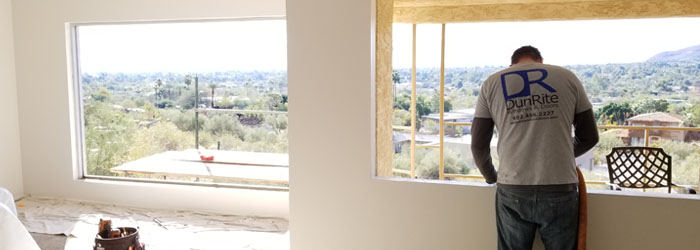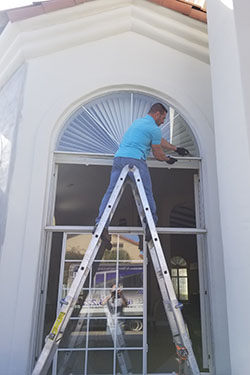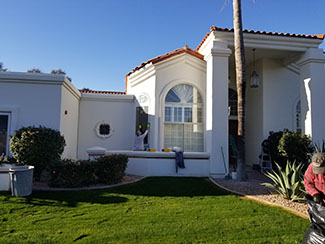How Hard Is It to Install New Windows?
 06 March 2018
06 March 2018 

What you Can expect at your house
OK, you signed a contract to have new windows installed in your home. What kind of mess will it be? Do you have to move out when workers are doing the job?
 No, it won't be a major remodel that will take weeks and weeks to complete, and homeowners don't have to remove all furniture from the house either, according to Sal Sucato of DunRite Windows and Doors in Phoenix.
No, it won't be a major remodel that will take weeks and weeks to complete, and homeowners don't have to remove all furniture from the house either, according to Sal Sucato of DunRite Windows and Doors in Phoenix.
"We may ask homeowners to remove valuables or knickknacks; we might ask the homeowner to move a grand piano out of the way," he said. "There's no dust or smoke, and we put drop cloths down everywhere. We can work around shutters and we take the blinds off and put them back on."
You might want to be on site during the installation so that you can answer questions or keep an eye on progress.
How long does it take to replace windows?
According to Sucato, a work crew of two can do six or seven windows a day and will probably work a 7 ½ hour day. If you have 12 windows, you can figure that it will take about one hour per window. If there are a lot of windows, like 30 or so, workers might be on the job five consecutive days, for example. They should not pull off the job until it's finished.
Do you have to do all windows in your home?
No, many homeowners decide to replace the most prominent windows in the back and front of the house or they might only replace windows on the side of the home that gets the most sun. Then they go back later and replace the rest when it suits their budget. Generally, companies have a three-item minimum for the number of windows per job.
What methods are used for replacement?
 There are some basic ways that windows are replaced. Although we aren't giving all the details here is a general description:
There are some basic ways that windows are replaced. Although we aren't giving all the details here is a general description:
- The glass from the old windows is removed and the old frame is collapsed and removed. Typically, the exterior stucco and interior drywall are not disturbed. After the new window and new frame are installed, the area around the new window will have a low expanding foam inserted to fill any void and will be caulked with a textured caulking to match existing stucco. This is only for a framed home with a stucco finish.
- Then there is a less costly method referred to as "frame jumping." This method is generally less desirable. The glass and center bars from the old aluminum frame are removed, but the frame is left intact. The new window frame will cover the old existing window frame. In the process about 1.5 inches of window glass is lost from each side as well as at top and bottom. No stucco repair will be needed. Depending on the size of your current windows this may or may not be a good fit for your home. Caulking will typically be the same color as the window frame and will look completed when workers leave. The caulking bead will attract dust over the years and may later need painting by the homeowner.
- A more expensive method that gives better results is to cut away the stucco on all sides about three inches away from the old frame. After that the old window frame is removed. The new window frame is installed as a new style installation method. Everything is rebuilt with new flashing, foam and stucco to blend into existing walls. This method could cost up to $200 to $300 more per window. This type of replacement can only be used for framed homes.
- After any of these replacements, the caulking and stucco work has to be done very carefully, of course, in order to match the texture of the old stucco. Repainting the whole house might make you happier.
Sal Sucato says that Arizona homeowners will be amazed at how much less heat is transferred through their new windows, compared with the old. He recommends that homeowners check out energy performance ratings issued by the National Fenestration Rating Council before buying various products. The council has a Solar Heat Gain Coefficient that measures how well a product blocks solar heat. To simplify things, make sure to get three coats of low-e material as well as having argon in the double pane glass.
###
Photo Credits:
RELATED CONTENT:
- Blog: Windows: What Terms You Need To Know Before You Shop
- Blog: Five Reasons Why You May Want New Windows
- Blog: Six Things You Need To Know About New Windows
- Podcast: What You Really Need to Remodel in Your New Home
Print this page
recent post
- Duck, Duck, Duct! How Often Should Ductwork Be Cleaned?
- Vinyl vs. Fiberglass Windows: Which Is The Better Choice Of Replacement Window?
- We May Be The Grand Canyon State, But The Rocky Mountains Are Important For Arizona
- Welcome to Arizona! Things A Newbie to Arizona Should Know
- The Pros & Cons of Buying A Flipped House
- Getting In On The Ground Floor
- Why It’s More Critical Than Ever To Get Your AC Serviced Before Summer
- The Reality of Remodeling
- What To Look For When Comparing Your Roofing Quotes
- What To Expect When Buying New Windows & Doors
